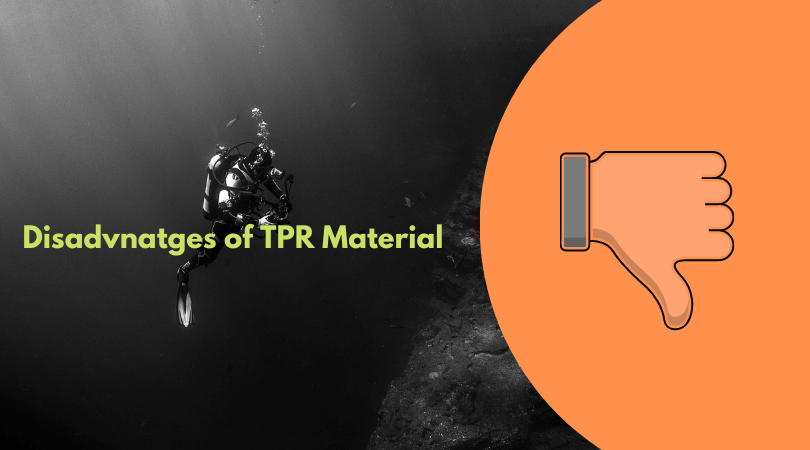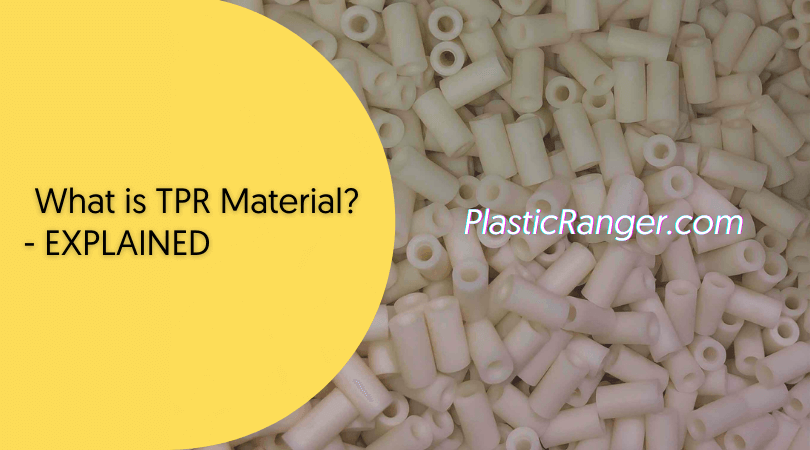Hello People. Thermoplastic rubber is one of the most salient human inventions in terms of innovation related to plastics. Let’s look into it from a more refined perspective.
What is TPR material?
In basic terms, Thermoplastic Rubber (TPR) is a substance that possesses the properties of both rubber and plastic. Thanks to its elasticity and rubber-like composition, TPR effectively distributes impact energy away from bones, lessening the force of the impact.
TPR material exhibits excellent physical properties and is best suited for processing in Injection Molding. However, it has various applications and is utilized in multiple domains to mold into dozens of products.
TPR possesses physical attributes of rubber and plastics, perfectly engineering in sync with specific thermoplastic and elastomeric properties.
Some salient features TPR material exhibits include flexibility, good tear resistance, reusability, recyclability, and good abrasion resistance.
TPR Properties

As mentioned earlier, ThermoPlastic Rubber (TPR) has the properties and features of both plastics and rubber; the list of beneficial properties is also quite impressive. It packs both thermoplastic and elastomeric characteristics. Let’s go through the list.
- Good dielectric properties
- Excellent resistance to weathering and chemicals
- High convolution fatigue strength
- Availability in a wide range of durometers.
- Broad temperature range
- Recyclable and reusable
Here’s a table with the specific properties of Thermoplastic rubber.
| Physical Properties | |
| Tensile Strength | 0.5 – 2.4 N/mm² |
| Thermal Coefiecnt of Expansion | 130 x 10-6 |
| Notched Impact Strength | no break Kj/m² |
| Density | 0.91 – 1.3 g/cm3 |
| Max. Continues to use Temp. | upto 140°C |
| Chemical Resistance | |
| Oils and Greases | Very Good |
| Dilute Acid | Very Good |
| Dilute Alkalis | Very Good |
| Aliphatic Hydrocarbons | Very Good |
| Halogenated Hydrocarbons | Good |
| Alcohols | Good |
| Aromatic Hydrocarbons | Poor |
Engaging Content – What is HDPE Material? | HDPE Properties | Advantages of HDPE | Disadvantages of HDPE | The Future of HDPE
Advantages of TPR Material

- TPR can be processed in traditional plastic machinery or equipment. No need for high-tech, auto, or semi-auto molding machines.
- Numerous customization options provide an opportunity to produce many different kinds of products.
- TPR can be co-molded and co-extruded with different kinds of plastics. The various customization options play a crucial role here.
- It has a faster production cycle compared to thermoset rubber.
Disadvantages of TPR Material

Although TPR comes with a tremendous amount of benefits, it even has some critical shortcomings to discuss.
- Hardness is TPR’s main property, which helps it maintain excellent chemical and weathering resistance. Still, it can backfire as no softness increases material handling and processing complications.
- Poor bending also has similar effects, making processing material more complicated.
- Minor TPR shortcomings include material weight, poor shock absorption, and poor permeability.
Applications
Thermoplastic Rubber is a mainstream manufacturing material utilized by various verticals to make top-notch quality products. Let’s delve deep into its applications.
Automotive Industry
The automotive industry is one of the primary users of TPR material. Due to its excellent resistance to weathering, oils, and abrasion, TPR is used to manufacture various automobile components.
These include weather seals, gaskets, hoses, and mats in cars and trucks. Additionally, TPR produces high-quality soft-touch interior elements such as gear knobs, dashboard trims, and door handles.
Its unique combination of strength, flexibility, and durability makes TPR an ideal choice for enhancing vehicles’ appearance and functionality.
Consumer Goods
TPR is extensively used to produce consumer goods, such as footwear, toys, and household items. Its flexibility and cushioning make it a popular choice for manufacturing comfortable and durable shoe soles.
TPR’s ability to mimic the texture and appearance of rubber while being lightweight and easy to mold has made it a preferred material for creating a variety of toys, from action figures to squeeze toys.
In household items, TPR can be found in the grips of kitchen utensils, tool handles, and even toothbrushes, enhancing the comfort and usability of these everyday products.
Medical Industry
The healthcare industry benefits from the use of TPR in numerous applications. TPR’s hypoallergenic and non-toxic properties make it suitable for manufacturing medical devices and equipment in contact with the human body.
Examples include catheters, syringes, and tubing. TPR also produces orthopedic devices, such as insoles and braces, due to its shock-absorbing and cushioning capabilities.
Additionally, its resistance to sterilization processes contributes to its widespread use in healthcare settings.
Electronics
TPR has found a niche in the electronics industry, particularly in producing cable jackets and connectors. Its excellent electrical insulating properties, heat, flame, and chemical resistance, make TPR a sought-after material for ensuring the safety and longevity of electronic devices.
TPR also manufactures smartphone cases and accessories, providing a soft, non-slip grip and enhanced protection against drops and impacts.
Sports and Recreation
The sports and recreation sector also takes advantage of TPR’s unique properties. It is used to manufacture sports equipment, such as protective gear, athletic shoe soles, and fitness accessories like resistance bands and exercise mats.
TPR’s ability to maintain flexibility and resilience across a wide temperature range makes it well-suited for outdoor and water sports equipment, including goggles, swim fins, and scuba gear.
Sports and Recreation
The sports and recreation sector also takes advantage of TPR’s unique properties. It is used to manufacture sports equipment, such as protective gear, athletic shoe soles, and fitness accessories like resistance bands and exercise mats.
TPR’s ability to maintain flexibility and resilience across a wide temperature range makes it well-suited for outdoor and water sports equipment, including goggles, swim fins, and scuba gear.
What is a ThermoPlastic Resin?
Thermoplastic resin is a plastic material that liquefies quickly to excellent moldability when heated to a specific temperature and solidifies as it cools down. Such a quick reaction to heat and cold thermoplastic resin can be shaped into various structures, making them viable for many industries.
An array of commercially available thermoplastics, nylon, Acrylic, and polycarbonate can be used for various applications.
For example, Acrylic has multiple applications in industries like aquariums, signs, windows, and medical devices. Nylon is used to produce gear wheels and ropes. For almost any industry, there is a thermoplastic, which can come in handy.
Thermoplastic resins form chemical bonds in the injection molding process called polymers. The bonding of various molecules secluded in the polymer chain will decide the plastics’ characteristics.
When the resins are heated, the molecular and about which we discussed now weaken. As a result, it transforms into a ferocious liquid, which is poured into a molding tool. Once the resin cools, the polymer chain becomes solid, producing your desired part.
Engaging Read – 6 Best Plastic Molding Techniques | A Complete Analysis
TPR VS TPE

People get confused between those two materials a lot. TPR and TPE are both classified as thermoplastics.
On the surface, both materials seem very similar, and to some extent, they are. However, they have several differences, making their application quite different.
TPE and TPR are modified versions of different materials.
TPR is changed from SBS material, and TPE is usually modified from SEBS material.
TPR is known for its hardness during the molding process. On the contrary, TPE’s SEBS material is regarded for its softness.
TPR material has characteristics of both rubber and molding abilities thermoplastics.
TPR provides increased flexibility compared to TPE. Additionally, the wide variety of physical ranges makes TPR stand out, making it useful for many purposes.
The Interesting History of Thermoplastic Rubber
The early origins of TPR are not widely known to the public, but it first appeared on the market in 1959. Since then, a broad range of variations have been developed.
Six primary groups are commercially available: thermoplastic polyurethanes (TPE-U), polyolefin blends (TPE-O), elastomeric alloys, thermoplastic copolyesters (TPE-E), styrene block copolymers (TPE-S), and thermoplastic polyamides (TPE-A).
Each of these variants is utilized in various applications, depending on the specific needs of the end consumer.
The Shore Durometer Scale
Shore durometer scales are used to measure the hardness of different materials. As I praised TPR’s hardness in the last paragraph, the hardness ranged from 20 Shore OO to 85 Shore D when measured with highly dependable shore scales.
As a professional who has worked in the plastics industry for almost five years, I believe if you’re contacting someone to deal with TPR material, find a company with good experience because TPR can only be processed in Injection Molding, and finding relevant expertise would increase your chances of manufacturing accurate and perfect quality products.
Engaging Read – What is Polypropylene Material?
TPR Toxicity
TPR plastic is safe as it is free of BPA, making it suitable for products used by children and pets.
TPR is commonly used in food and toy items and medical applications like catheters due to its softness and affordability.
As you all must know, TPR has a significant amount of rubber in it, making it Impervious to grime and non-tacky, making it easy for consumers to clan the products made from it.
FAQs

Below are the frequently asked questions on TPR Rubber. Let’s get a quick take on some queries that bug most people.
What is TPR used for?
It is mostly used in the footwear and toys industry for gluing purposes. However, it doesn’t react well with adhesives. Several applications are so prevalent in the Tubing and Wires & Cables industries.
How do you clean thermoplastic rubber?
Cleaning it with warm water and a mild soap is advisable. To reach the tinier and more curvy areas, you can use a toothbrush to remove dust and debris. Moreover, wiping should be primarily done with a clean and dry towel after cleaning it with water.
Are TPR products waterproof?
It is mainly used in products used for outdoor activity (mainly for waterproof soles in footwear). Soles of thermoplastic rubber have a good grip on runny and slippery roads. The soles would be lighter in weight but would have a rougher texture.
Which is better, TPR or PVC?
Both materials are used to make hoses, but TPR hoses are smoother and have better abrasion resistance, efficient airflow, and minimum friction loss than PVC. As a result, they are suitable in conditions involving high temperatures, chemicals, moisture, and UV exposure.
Is TPR heat resistant?
It becomes heat resistant after cross-linking. However, excessive heat will vulcanize it and yield water and silica after combustion.
Suggested Read
- What is the Glass Transition Temperature of Plastics?
- Plastics Vs. Polymers | What are the Differences?
- Food Grade Plastic: The Best Plastics for Food Applications
Conclusion
The article concludes that Thermoplastic Rubber (TPR) is a versatile and cost-effective material that bridges the gap between plastic and rubber. With features like high flexibility, reusability, and resistance to weather and chemicals, TPR has become a go-to choice in industries like automotive, medical, and consumer goods.
Its environmentally friendly nature, owing to its recyclability, is an added advantage. TPR’s unique characteristics make it an invaluable asset for various applications.
I trust you found this article informative and comprehensive. I’ve strived to include all pertinent information. Your feedback in the comments section would be highly appreciated. Wishing you an excellent day.
Quick Navigation


Nice information and especially the tpr vs tpe part was something I was looking for.
Thank you very much
how to make TPR granules. what materials are required to make TPR granules. what equipments are required
I’m glad to have found this article. It has been very helpful.
Thanks
This guide was super helpful! I had heard about TPR material but didn’t know much about its properties and applications. The detailed breakdown really clarified things for me. Thanks for sharing such informative content.
Thanks